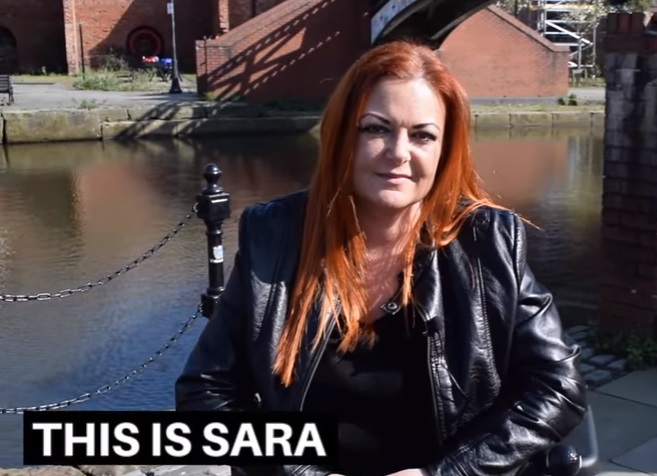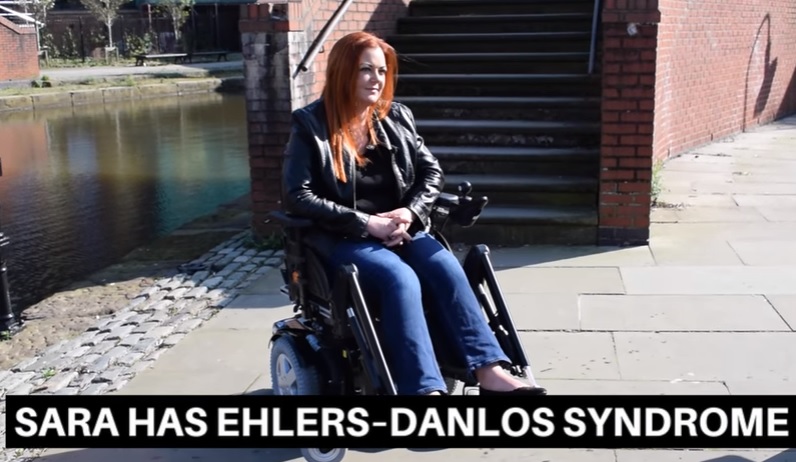An invisible illness: what it’s like living with EDS
- 15.05.2017
- EmmaArnold
- None

There are many different types of EDS, the rare genetic condition which affects the connective tissue that supports your skin, bones and ligaments.
Sara is one of only a handful of people in the UK, and worldwide, with a specific kind of extremely rare EDS (Arthrochalasia or Type 7a). This is a multi-systemic condition; the effect on the body is widespread and not limited to one body system but ever system which has collagen in it and collagen makes up 30-40% of all protein in the human body. She said:
I can’t even pick up a bag of shopping without my shoulder dislocating. Even the weight of my arm resting can pull my shoulder out, and my left shoulder is permanently dislocated now. I do have extreme hypermobility and extremely shallow joints with the type of EDS I have compared to other EDS sufferers, the most common form being the Hypermobile type or Type III.
Living in constant pain is a real skill in itself and no one realises how debilitating and tiring it is. People with EDS are often diagnosed with Chronic Fatigue Syndrome (CFS) as our bodies take around twice as much effort to move and control opposed to non-EDSers. As I age, the constant accumulative effect of the daily trauma of my joints dislocating means I have permanent damage to bones and soft tissues.
The premature osteoarthritis and ligament ruptures cause a lot more pain and disability and for the past 20 years I have lived on massive dose of opiates just to do the daily physical things, like getting out of bed in a morning, that the vast majority of people take for granted. EDS is classed as an invisible illness as there are a lot of us who don’t ‘look’ like we are ill or in pain. I talk about major joint dislocations and complex surgery as if it is a common occurrence, which to me it is. I can’t honestly remember my last pain free day, if ever! I survive on my pain management regime and I feel extremely fortunate that I now have a solid team of medical experts who support me to have the best quality of life that I can under extremely challenging circumstances.
Sara was born with both her hips dislocated and had other issues as she grew like flat feet and knee caps which ‘popped’ as well as painful shoulders when lifting a school bag for example.
I was constantly in trouble at school for leaving my bag on the floor as every time I picked it up, my shoulder would dislocate, so I’d drop it back down again. I didn’t know at the time that this was what was happening, I just thought I was a wimp as this must happen to everyone but everyone else didn’t complain; I now know much differently!

Sara’s worst orthopaedic issues were with her knees and she saw numerous orthopaedic surgeons, rheumatologists and various other conventional and complementary medical professionals. She said she was basically labelled as mad and went through the whole spectrum of it being psychosomatic and it all in her head to being self-inflicted as she bruises with real ease, especially from a dislocation.
It was only when she was 17 and saw a new orthopaedic surgeon who did bone scans and her left knee cap dislocated spontaneously during the scan that her knee problems were taken seriously and surgical intervention was begun to try to stabilise and correct valgus deformity.
Multiple complex procedures were undertaken which lead to a total left knee replacement at the age of 26 with a cemented long stemmed TC3, which had to be revised at 29 as the knee mechanism was not stable due to a small amount relying on her own soft tissues, which due to the EDS weren’t sufficient. The revision was to a rotational hinge endolink, and for the first time in her life, she knew what a stable knee joint felt like.
Having previously been told it was medically impossible for a whole knee to spontaneously dislocate, something which Sara could demonstrate at will. Her right knee was replaced with a rotational hinge endolink at 29 and since then, she has had a Stanmore fixed hinge prosthesis in both her left and twice in her right knee as well as multiple other complex procedures prior to replacement in attempts to straighten her legs and stabilise her knees.
At 19 years old, Sara fractured her right wrist from her left knee giving way under her as she was walking. The scaphoid fracture was treated with a plaster but when the plaster was removed, doctors noticed her wrist and arm were repeatedly swelling and so she was referred to a specialist hand surgeon. A wrist arthroscopy was undertaken and it was found that as well as the unhealed scaphoid fracture there was also extensive ligament ruptures.
A Blatt procedure was performed where a piece of capsule is threaded through a hole drilled into the scaphoid bone to try to stabilise the damage. Pins and wires were also used as well as a cast for four months to hold everything stable during healing. After removal of the pins and cast, the reconstructed soft tissues stretched back within two weeks much to the amazement of the hand team.
My hand surgeon sat me down and chatted to me about my past orthopaedic surgeries and any complications I may have had. I explained that any soft tissue surgery I had in the past had been unsuccessful, even when I had carbon fibre ligament reconstruction of all four ligaments in my left knee, the first time I put any weight through it, five months down the line, my whole knee dislocated again.
The next time Sara saw her hand surgeon, he handed her a leaflet with a funny medical name on the front and asked her to read it in the waiting room before her appointment with him.
It was like an epiphany. It was like this leaflet was written about me. Little things like how EDS can make your teeth move – which had confused my dentist so much! – was linked into place. Finally it all made sense. I know it is only a label, but it did authenticate everything and prove that what I was experiencing was actually real and I wasn’t ‘mad’!
Medial patella dislocations and spontaneous dislocations of the whole knee – things most doctors have never seen before – all confirmed the fact that she had the condition along with her extreme hypermobility, poor wound adhesion and healing, bruising and bleeding and fractures that simply would not heal and unite.
When you’re told that something is medically impossible, obviously doctors find it incredibly hard to believe, but then when I demonstrate it, they have to believe. Doctors now discuss everything with me. For example, because I take twice as long to heal I now have sutures opposed to clips and they are left in for at least twice as long.
Living in constant chronic pain means anxiety and depression can be a common symptom of EDS but Sara says she remains a positive outlook despite the constant pain.
I’m a 'glass half full' type of person. I seem to spend a lot of my time fighting myths and people’s incorrect judgements more than anything else. People often misjudge disabled people and think they are lazy and don’t want work but then they may see someone like me and my multiple scars and think again, as it validates it for them. No one knows what goes on behind closed doors. I don’t live life for drama; this is my life. You have to make the best of it. You can’t press ‘stop’ and then re-record when things are better. You’ve just go to live your life, live it to the full and make the most of it. Life is extremely precious and no one is guaranteed of a tomorrow, so make the day count for you and count your positives. Some days just getting out of bed may be the only positive of the day, but hey, it’s still a positive right?
EDS was once considered to be extremely rare; now not as rare but more under-diagnosed. Years ago, the vast majority of doctors were unaware of the condition thus it can often remain undiagnosed for many years as in Sara’s case. Her type of EDS is extremely rare, but the most common type of EDS is considered to have a prevalence of around 1:5000 these days, not as rare as originally considered more under-diagnosed. Plus, increased training in rare diseases means more medical professionals are becoming more aware of the condition.
Sara said:
When I look back at fractures that haven’t healed in the past, now I know why. If I was born now then things would, hopefully, be a lot different with treatment, support and even the painkillers prescribed. Unfortunately, it is not an uncommon tale of misdiagnoses for EDSers and the majority do have similar tales to tell which is why we all have to raise awareness to encourage research and hopefully a structured and accepted diagnoses criteria and treatment strategies in a meaningful and cohesive way.
Awareness in the general public is also increasing gradually; Cherylee Houston has EDS and became the first full-time disabled actress to appear on our screens in Coronation Street. As a Patron of the Ehlers-Danlos Support UK group, she is raising awareness of the illness as her soap character also suffers with EDS.
Although general opinion about disability and wheelchair-users is improving, Sara believes there is still quite a way to go. Some disabilities, like EDS, are ‘invisible’ which can provoke unwanted negative opinion and harsh judgements.
She said:
I believe passionately in challenging and changing society’s negative attitude towards disability. I believe attitudes can be altered but it would have to be challenged at a national level for example by making disability equality training a statutory requirement for all businesses by a nationally devised and accredited training programme. There is a lot of ignorance and fear which exists around the stigma of disability and a lot of people are afraid of saying the ‘wrong thing’ to a disabled person, so they will avoid the situation completely by not employing a person with a disability instead of upskilling themselves in that area.
It is a real shame, because there are a lot of highly skilled people with disabilities who are simple discredited and overlooked by something which should be irrelevant as well as being a ‘protected characteristic as defined by The Equality Act. I hold a Masters degree so, although I’m a wheelchair user, I think that proves that quite obviously my brain works rather well! Disability can happen to anyone at any time: an acquired brain injury, a car accident, simply tripping up and falling over and hitting you head so perhaps people need to show more compassion and thought towards this group of people who have enough daily challenges without having to fight ignorance and myths too.
Sara came to PotterReesDolan with a clinical negligence claim after revision surgery left the femoral component of her right knee 40 degrees internally rotated. After the surgeon refused he had made a mistake, Sara visited Robert Jones and Agnes Hunt Orthopaedic Hospital where x-rays and scan have confirmed internal rotation.
